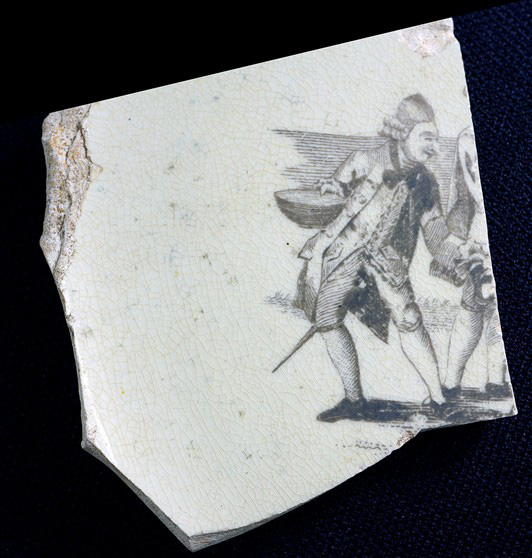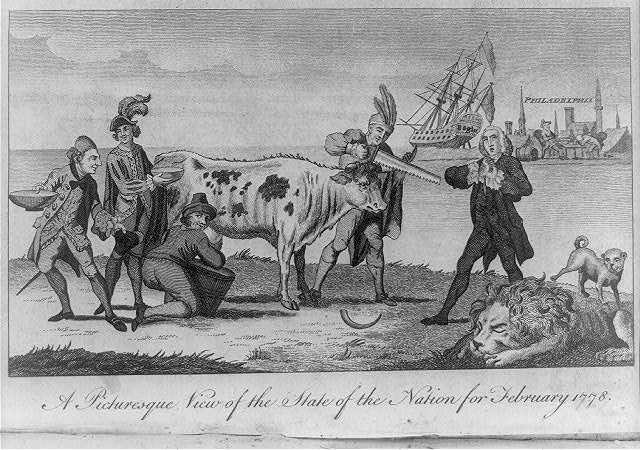April 2014 — Artifact of the Month
back to PAF Home
Artifact of the Month Index
POLITICAL POTTERY
This small fragment of black transferprinted creamware depicting a Frenchman holding a punchbowl, likely from a plate, tray or platter, depicts one of the most popular political cartoons of the eighteenth century. Excavated from a privy at the National Constitution Center site, the sherd speaks to the political and military upheaval of the late eighteenth century Atlantic World, and the toll it took on the British Empire.
The artifact’s image was originally part of a larger scene based on the satirical cartoon, “A Picturesque View of the State of the Nation for February 1778″ (see below). Published in London’s Westminster Magazine, on March 1, 1778, the original print suggests that Britain is being “milked” of its resources, particularly commerce, by other European powers, depicted here as France, Spain and the Netherlands, due to the diversion of the American Revolution. The American, pictured in a feathered headdress, saws the horns off the British milk cow, symbolically removing Britain’s dominance and power.
The scene also mocks the behavior of the brothers Howe, the British occupiers of Philadelphia, whose enthusiastic participation in Philadelphia society and culture, particularly its theater and gambling establishments, was well known. The brothers appear in the background, slumped and asleep at a table. Between them rests a punchbowl, with a keg to the side — a marker of the ill conduct of the Howe’s during their nine month occupation of the capital city. Perhaps most insulting is a poor Englishman, woefully wringing his hands as the British lion, sleeping quietly to the side, is urinated upon by French pug.
The print was so popular in England that it quickly found its way onto other mediums, including ceramics. Printing on ceramics was still quite new in the late 1770s, when the featured archaeological example was made, making such wares highly desirable, although often short lived. Political ceramics, as well as their source prints were quite faddish, quickly moving in and out of fashion as current events progressed ever forward. It is likely that this print was not used on ceramics after the early 1780s, if not before.
Interestingly, the American Revolution made procuring such wares extremely difficult. Philadelphia, along with many other American ports, was subject to British blockades and also suffered from a dramatic decrease in Atlantic commerce brought on by the War, particularly after the formal entrance into the conflict of the French in 1778 and Spanish in 1779. Philadelphia newspaper advertisements for ceramics, textiles, food stuffs, etc., are all but absent during the revolutionary period, leaving one to ask: How did this sherd makes its way from England to the Philadelphia city block now occupied by the National Constitution Center?
Contributed by Debbie Miller, Independence Park Archeology Lab, Independence National Historical Park.
back to PAF Home
Artifact of the Month Index
by admin

